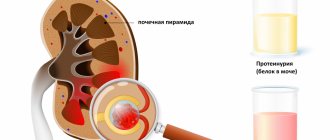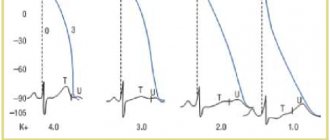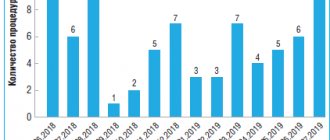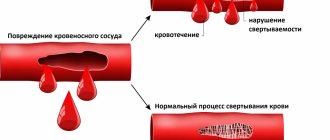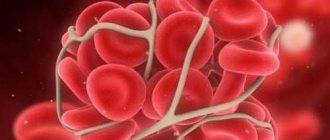Atherosclerosis
Stroke
COVID-19
18207 April 13
IMPORTANT!
The information in this section cannot be used for self-diagnosis and self-treatment.
In case of pain or other exacerbation of the disease, diagnostic tests should be prescribed only by the attending physician. To make a diagnosis and properly prescribe treatment, you should contact your doctor. We remind you that independent interpretation of the results is unacceptable, the information below is for reference only
D-dimers are fragments of the fibrin molecule formed during its breakdown. They received this name because they contain two connecting D-fragments of the fibrinogen protein.
D-dimer: indications for use, rules for preparing for the test, interpretation of results and normal indicators.
Indications for the purpose of the study
Damage to the vascular wall triggers a cascade of physiological reactions in the body aimed at preventing bleeding. The result of these processes is the formation of a blood clot consisting of blood cells and fibrin protein. Normally, factors that promote blood clotting and factors that prevent its development are in balance.
Formation of a blood clot, or blood clot, that blocks bleeding
As a result of the work of the fibrinolytic system, fibrin is split into smaller fragments, so the clot does not spread from the site of vessel damage throughout the entire vascular bed. In this case, various fibrin degradation products of different molecular weights are formed, among which there are D-dimers.
Illustration “Fibrin Degradation” Caption Fragments of the fibrin molecule formed during its breakdown
The level of D-dimer in the blood reflects both the formation of fibrin and its dissolution.
An increase in plasma D-dimer levels is observed approximately 2 hours after the onset of thrombosis.
D-dimer is metabolized in the kidneys, its half-life with preserved renal function is approximately 6-8 hours. Malfunctions of the fibrinolytic system can lead to increased formation of blood clots.
An increased level of D-dimer in the blood indicates actively occurring thrombus formation processes, but does not allow one to judge the localization of the thrombus, therefore, determining the level of D-dimer in the blood plasma is used to exclude thrombosis of any location.
Patients with high D-dimer levels require instrumental examination to confirm or rule out thrombosis.
Patients with initially high D-dimer concentrations have approximately 3.5 times the risk of developing venous thromboembolic complications (VTE) than patients with low concentrations.
VTEC includes:
- deep vein thrombosis of the lower extremities;
- saphenous vein thrombosis;
- pulmonary embolism (PE).
At risk of developing VTEC are:
- aged people;
- overweight people;
- pregnant women;
- patients with cardiovascular diseases (CVD);
- post-stroke patients in the intensive care unit (ICU);
- patients after extensive surgery, trauma, burns;
- patients with cancer;
- septic patients.
D-dimer may increase in the absence of venous thromboembolic complications. The reasons may be:
- fibrinolytic therapy (therapy aimed at dissolving blood clots) in the previous 7 days before the study;
- myocardial infarction;
- atherosclerosis;
- sepsis, severe infections;
- cirrhosis of the liver;
The D-dimer content increases significantly during pregnancy and reaches a maximum in the third trimester. This process has physiological significance and is aimed at reducing blood loss during childbirth.
High concentrations of D-dimer can be detected in women with pregnancy complications (preeclampsia, preeclampsia), in pregnant women with diabetes mellitus and kidney disease. Assessing the level of D-dimer in patients with a history of complicated pregnancy allows us to identify risk groups for whom antithrombotic prophylaxis is mandatory. If there is a genetic predisposition to thrombosis, an increase in D-dimer levels in the first trimester of pregnancy may indicate a high risk of thrombotic and obstetric complications.
DIC syndrome (disseminated intravascular coagulation syndrome) is characteristic of sepsis. The appearance of blood clots in the microvascular bed leads to disruption of the functioning of organs and systems and the development of multiple organ failure. Increased D-dimer levels are found in almost 95% of patients with sepsis.
Normally, D-dimer levels increase with age due to decreased renal clearance of plasma proteins, increased fibrinogen levels, and/or the presence of underlying and systemic diseases.
Thus, the determination of D-dimer is used for diagnosis:
- thrombotic conditions (deep vein thrombosis, often complicated by pulmonary embolism);
- DIC syndrome;
- complications during pregnancy;
- post-Covid syndrome.
In addition, the study is necessary to monitor anticoagulant therapy (determining its duration, effectiveness and dose of prescribed drugs).
D-dimer during pregnancy
When managing pregnancy, determining the level of fibrinogen in the blood plasma is of great importance. The closer the due date, the higher these indicators. It should be taken into account that an excessive increase in fibrinogen levels does not always fit into the normal range; sometimes it is a sign of deep vein thrombosis.
Before childbirth and directly during childbirth, it reaches its maximum level, after 3 days it rapidly declines, and after 30-35 days it reaches standard values.
Table: D-dimer norm by days of pregnancy:
| Gestational age | Normal D-dimer values by week of pregnancy in ng/ml | µg FEU/ml |
| Up to 13 weeks | Up to 280 | Up to 0.56 |
| 13 – 20 weeks | 100 — 700 | 0,2 – 1,4 |
| 21-28 weeks | 150 — 850 | 0,3 – 1,7 |
| 29 – 35 weeks | 150 — 1500 | 0,3 – 3,0 |
| From 36 weeks until birth | 200 — 1550 | 0,4 – 3,1 |
1 µg FEU/ml = 500 ng/ml
In accordance with the data in the table, we can conclude that during pregnancy, the concentration of the marker increases with increasing gestational age. Deciphering its meanings will help prevent pathologies of pregnancy and childbirth, and supplement the information obtained from traditional analysis of coagulogram results.
What does elevated D-dimer mean?
Even a slight increase in this indicator may indicate probable thrombosis. If the D-dimer reaches 273 ng/ml or higher, it is deadly.
D-dimer is elevated in many diseases:
- cardiac ischemia;
- acute coronary syndrome;
- thrombosis of the pulmonary artery (PE) or deep veins;
- DIC syndrome;
- acute or chronic heart failure;
- infections, injuries;
- sepsis;
- hematomas;
- kidney disease;
- preeclampsia and gestosis in pregnant women;
- coronavirus COVID-19;
- old age (over 80 years);
- malignant neoplasms.
The D-dimer level depends on the size of the clot, as well as the time and duration of taking thrombolytic drugs or anticoagulants.
With a decreased D-dimer level, the patient's risk of bleeding increases, so the patient needs to consult a hematologist and other specialists. Doctors conduct additional examinations and laboratory tests and prescribe an appropriate course of treatment.
Reasons for increased D-dimer in pregnant women
A coagulogram is a mandatory comprehensive screening examination of women carrying a child. Hematological parameters are monitored at every trimester.
As part of the coagulogram, the concentration of D-dimer is determined, which varies depending on the stage of pregnancy. After the 35th week, the indicator can be 3-4 times higher than the established reference value.
Main reasons:
- preeclampsia is a multisystem pathological condition characterized by arterial hypertension and proteinuria;
- gestosis – late toxicosis, which is manifested by frequent vomiting, swelling, and a sharp drop in blood pressure;
- disturbance of glucose metabolism;
- varicose destruction;
- acute bacterial and viral infection.
D-dimer (the norm in women by age during the period of fertility practically does not change) increases with complicated pregnancy and concomitant pathologies. Deviations occur when there is a threat of miscarriage, placental abruption, or other dangerous conditions.
Physiological
This is a category of causes that are considered natural. An increase in a specific marker of thrombus formation is associated with hormonal changes and the occurrence of special physiological processes. During childbirth, about 500 ml of blood is lost. This is reflected in fibrinolysis, which is enhanced to restore hematological balance.
The separation of the placental membrane is a factor that stimulates the breakdown of non-globular protein. A low platelet count does not allow bleeding to be quickly stopped. As a result, the loss of biological fluid can become critical and life-threatening.
Physiological blood thickening is different:
- decreased clotting time due to increased secretion of platelets;
- acceleration of fibrinolysis, as a result of which the concentration of D-dimer rapidly increases;
- shortening the period necessary for the formation of blood clots;
- increased levels of megakaryocytes.
Physiological reasons for an increase in D-dimer concentration do not require medical response, since they are natural. Over time, the indicator independently returns to the reference value.
Pathological
If in the early stages of pregnancy a significant excess in the concentration of the fibrin breakdown product is detected, additional diagnostics are carried out to determine the etiological factor of the deviation.
An increase in D-dimer in the 1st and 2nd semesters is observed with:
- the threat of blockage of arterial beds by blood clots;
- violation of the rheological properties of blood;
- coagulopathic syndrome;
- pulmonary thromboembolism;
A false positive test result is possible in case of liver pathologies, acute inflammation, and tumor neoplasms.
What does D-dimer show in a blood test?
A blood test for D-dimer (also called dedimer) shows whether there are small blood clots in the bloodstream. These clots can clog blood vessels and cause life-threatening conditions:
- deep vein thrombosis;
- heart attack;
- stroke;
- pulmonary embolism.
To assess the risk of such serious diseases, doctors prescribe patients to do a D-dimer test.
Blood from a vein is donated on an empty stomach in the morning. You must not eat 8 hours or smoke 2 hours before the test. You are allowed to drink only water; tea, coffee, juices and other drinks, especially sweetened ones, should be avoided. The result is ready within 2 days.
Preparing for analysis
Like any other test for collecting venous blood, it must be taken in the morning on an empty stomach (the last meal is 8-10 hours before). Before the analysis, you are allowed to drink still water. It is permissible to donate blood during the day, but only 4 hours after a light meal.
The day before taking blood, any psycho-emotional and physical stress and alcohol intake are usually excluded. You should not smoke half an hour before the procedure, including electronic cigarettes.
Important! The results are released within 24 hours, and the day of blood donation is not included in the calculation. The result may be distorted if the preparation rules and anticoagulants are not followed.
D-dimer: what kind of analysis is it?
Checking the condition of the blood and the possible presence of clots in it is carried out using a blood test. There are two types of tests:
- Quantitative - reveals whether the D-dimer level is elevated or within the normal range. The results show o (increased) or “no” (normal).
- Qualitative - the exact number of D-dimer is indicated in numbers.
Quantitative analysis is more informative and provides doctors with more information about the condition of the patient's bloodstream. During the treatment of hemostasis, the analysis is carried out several times. If the indicator decreases, it means that the blood clot is dissolving and the patient is recovering. But high-quality analysis is cheaper and therefore more accessible to patients.
The test result will allow the doctor to accurately determine the risk of cardiovascular and cancer diseases in a particular patient.
Indications for analysis
Chest pain - indications for analysis
To assess the hemocoagulation system, analysis is recommended during pregnancy and in anticipation of surgery. To refute or identify pathologies, the concentration level of D-dimer is used if DVT, PE, or disseminated intravascular coagulation are suspected.
A doctor may refer you for diagnostics if the following signs occur:
- pain in the leg;
- swelling of the limb;
- cardiopalmus;
- chest pain;
- feeling of lack of air;
- bleeding from mucous membranes, hematomas.
